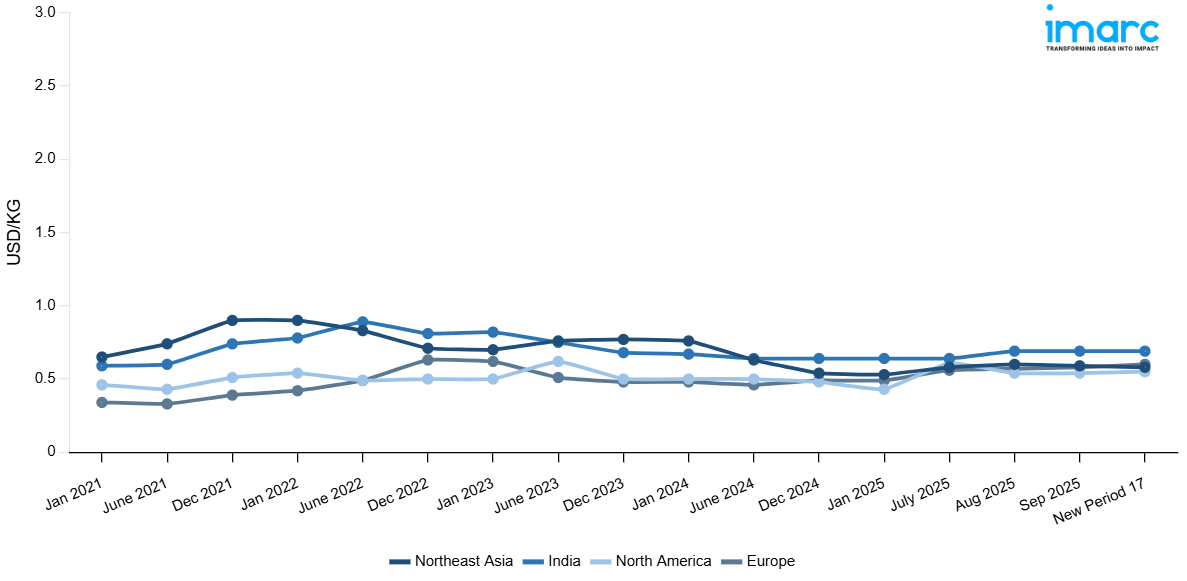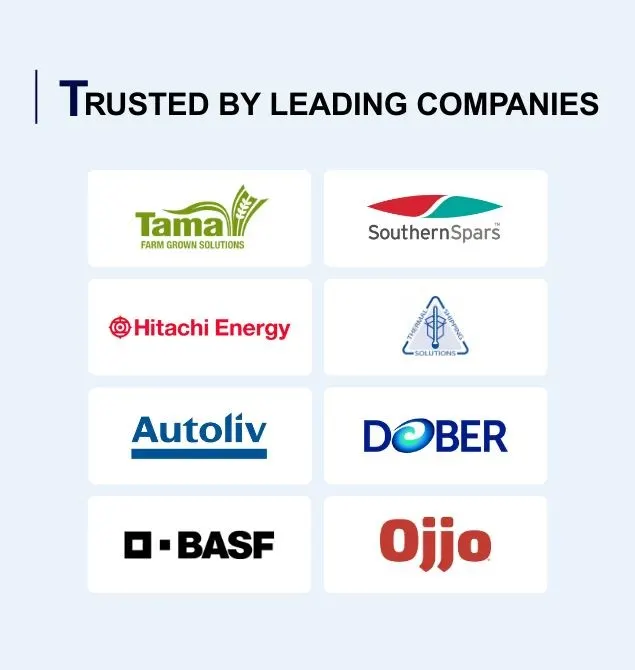
Sodium Silicate Prices, Trend, Chart, Demand, Market Analysis, News, Historical and Forecast Data Report 2025 Edition
Sodium Silicate Price Trend, Index and Forecast
Track real-time and historical sodium silicate prices across global regions. Updated monthly with market insights, drivers, and forecasts.
Sodium Silicate Prices October 2025
| Region | Price (USD/KG) | Latest Movement |
|---|---|---|
| Northeast Asia | 0.58 | -1.7% ↓ Down |
| Europe | 0.6 | 3.4% ↑ Up |
| India | 0.69 | Unchanged |
| North America | 0.55 | 1.9% ↑ Up |
Sodium Silicate Price Index (USD/KG):
The chart below highlights monthly sodium silicate prices across different regions.

Get Access to Monthly/Quaterly/Yearly Prices, Request Sample
Market Overview Q3 Ending September 2025
Northeast Asia: The Northeast Asian sodium silicate market experienced downward pricing pressures. The pricing decline reflected supply-demand rebalancing as regional production capacity adjustments normalized following earlier market tightness. Manufacturing sector demand from detergents and construction applications remained steady, though competitive market conditions and adequate inventory levels contributed to the downward trajectory. Energy cost fluctuations affecting production operations and raw material availability from silica sand and soda ash suppliers influenced cost structures, while currency dynamics and regional trade flows created additional pricing considerations throughout the period.
Europe: The market demonstrated upward pricing momentum driven by rising detergent consumption, high spending on household care products, and growing water treatment requirements across the region. Supply-side factors including production cost considerations and logistics efficiency influenced pricing structures, while strong demand as a detergent builder owing to superior emulsification, wetting, and deflocculation properties sustained consumption levels. Energy pricing stability and normalized supply chains contributed to the upward movement observed in September.
India: Indian market maintained stable pricing conditions, reflecting balanced supply-demand fundamentals and consistent industrial consumption patterns. Domestic production capacity adequately served regional requirements from detergents, textiles, and construction sectors without significant pricing pressures. Supply-side stability from established manufacturing facilities and steady raw material availability from silica and soda ash suppliers supported price equilibrium. Demand-side factors including consistent requirements from soap manufacturing, water treatment applications, and cement industries maintained steady consumption levels. Currency stability, normalized logistics operations, and competitive market conditions contributed to the unchanged pricing observed during the period.
North America: The demonstrated price stability due to adequate supply availability and consistent industrial demand patterns. Regional production capacity from major manufacturers maintained steady output levels, ensuring balanced market conditions without significant pricing pressures. Demand-side factors including requirements from detergents, pulp and paper, and water treatment sectors remained consistent with seasonal patterns. Supply chain normalization following earlier disruptions and stable energy costs supported production economics, while competitive dynamics among regional suppliers maintained price equilibrium. Raw material availability from domestic silica sand and soda ash sources contributed to the unchanged pricing trajectory observed during the reporting period.
Sodium Silicate Price Trend, Market Analysis, and News
IMARC's latest publication, “Sodium Silicate Prices, Trend, Chart, Demand, Market Analysis, News, Historical and Forecast Data Report 2025 Edition,” presents a detailed examination of the sodium silicate market, providing insights into both global and regional trends that are shaping prices. This report delves into the spot price of sodium silicate at major ports and analyzes the composition of prices, including FOB and CIF terms. It also presents detailed sodium silicate prices trend analysis by region, covering North America, Europe, Asia Pacific, Latin America, and Middle East and Africa. The factors affecting sodium silicate pricing, such as the dynamics of supply and demand, geopolitical influences, and sector-specific developments, are thoroughly explored. This comprehensive report helps stakeholders stay informed with the latest market news, regulatory updates, and technological progress, facilitating informed strategic decision-making and forecasting.
Sodium Silicate Industry Analysis
The global sodium silicate industry size reached USD 8.22 Billion in 2024. By 2033, IMARC Group expects the market to reach USD 11.81 Billion, at a projected CAGR of 3.90% during 2025-2033. The rapid industrialization activities, implementation of stringent environmental regulations, increasing urbanization and infrastructural development, widespread product utilization in water treatment, and increasing product adoption as an adhesive in automotive manufacturing are some of the major factors propelling the market.
Latest developments in the sodium silicate industry:
- October 2025: In a research study, the potential of sodium-ion batteries was put to test by synthesizing sodium iron silicate cathodes using aliphatic diols.
- July 2023: CIECH S.A., one of the largest suppliers of sodium silicates, has completed the construction of a modern warehouse facility to improve its logistical capabilities.
- January 2023: Solvay S.A. invested in its Livorno site in Italy to promote circular silica products made from bio-based sodium silicate.
- September 2022: Evonik Industries AG entered into strategic cooperation with Pörner Group and Phichit Bio Power Co., Ltd. to supply sustainably precipitated ULTRASIL silica to tire manufacturers.
Product Description
Sodium silicate is a colorless, flaked, inorganic compound of sodium and silica oxide, consisting of a silicate in the form of a counterion. It is manufactured by fusing silicon dioxide from sand and sodium oxide from soda ash. Commonly available in crystalline and anhydrous forms, sodium silicate is widely used in refractory cement, drilling fluids adhesives, mineral processing soaps, detergents and zeolites. Other than this, it exhibits various properties, such as enhanced stability in alkaline solutions, high temperature, acid and water resistance, and a strong adhesive. As a result, sodium silicate finds extensive applications across various industrial verticals.
Report Coverage
| Key Attributes | Details |
|---|---|
| Product Name | Sodium Silicate |
| Report Features | Exploration of Historical Trends and Market Outlook, Industry Demand, Industry Supply, Gap Analysis, Challenges, Sodium Silicate Price Analysis, and Segment-Wise Assessment. |
| Currency/Units | US$ (Data can also be provided in local currency) or Metric Tons |
| Region/Countries Covered | The current coverage includes analysis at the global and regional levels only. Based on your requirements, we can also customize the report and provide specific information for the following countries: Asia Pacific: China, India, Indonesia, Pakistan, Bangladesh, Japan, Philippines, Vietnam, Thailand, South Korea, Malaysia, Nepal, Taiwan, Sri Lanka, Hongkong, Singapore, Australia, and New Zealand* Europe: Germany, France, United Kingdom, Italy, Spain, Russia, Turkey, Netherlands, Poland, Sweden, Belgium, Austria, Ireland, Switzerland, Norway, Denmark, Romania, Finland, Czech Republic, Portugal and Greece* North America: United States and Canada Latin America: Brazil, Mexico, Argentina, Columbia, Chile, Ecuador, and Peru* Middle East & Africa: Saudi Arabia, UAE, Israel, Iran, South Africa, Nigeria, Oman, Kuwait, Qatar, Iraq, Egypt, Algeria, and Morocco* *The list of countries presented is not exhaustive. Information on additional countries can be provided if required by the client. |
| Information Covered for Key Suppliers |
|
| Customization Scope | The report can be customized as per the requirements of the customer |
| Report Price and Purchase Option |
Plan A: Monthly Updates - Annual Subscription
Plan B: Quarterly Updates - Annual Subscription
Plan C: Biannually Updates - Annual Subscription
|
| Post-Sale Analyst Support | 360-degree analyst support after report delivery |
| Delivery Format | PDF and Excel through email (We can also provide the editable version of the report in PPT/Word format on special request) |
Key Benefits for Stakeholders:
- IMARC’s report presents a detailed analysis of sodium silicate pricing, covering global and regional trends, spot prices at key ports, and a breakdown of FOB and CIF prices.
- The study examines factors affecting sodium silicate price trend, including input costs, supply-demand shifts, and geopolitical impacts, offering insights for informed decision-making.
- The competitive landscape review equips stakeholders with crucial insights into the latest market news, regulatory changes, and technological advancements, ensuring a well-rounded, strategic overview for forecasting and planning.
- IMARC offers various subscription options, including monthly, quarterly, and biannual updates, allowing clients to stay informed with the latest market trends, ongoing developments, and comprehensive market insights. The sodium silicate price charts ensure our clients remain at the forefront of the industry.
Key Questions Answered in This Report
The sodium silicate prices in October 2025 were 0.58 USD/KG in Northeast Asia, 0.6 USD/KG in Europe, 0.69 USD/KG in India, and 0.55 USD/KG in North America.
The sodium silicate pricing data is updated on a monthly basis.
We provide the pricing data primarily in the form of an Excel sheet and a PDF.
Yes, our report includes a forecast for sodium silicate prices.
The regions covered include North America, Europe, Asia Pacific, Middle East, and Latin America. Countries can be customized based on the request (additional charges may be applicable).
Yes, we provide both FOB and CIF prices in our report.
Need more help?
- Speak to our experienced analysts for insights on the current market scenarios.
- Include additional segments and countries to customize the report as per your requirement.
- Gain an unparalleled competitive advantage in your domain by understanding how to utilize the report and positively impacting your operations and revenue.
- For further assistance, please connect with our analysts.
Why Choose Us
IMARC offers trustworthy, data-centric insights into commodity pricing and evolving market trends, enabling businesses to make well-informed decisions in areas such as procurement, strategic planning, and investments. With in-depth knowledge spanning more than 1000 commodities and a vast global presence in over 150 countries, we provide tailored, actionable intelligence designed to meet the specific needs of diverse industries and markets.
1000
+Commodities
150
+Countries Covered
3000
+Clients
20
+Industry
Robust Methodologies & Extensive Resources
IMARC delivers precise commodity pricing insights using proven methodologies and a wealth of data to support strategic decision-making.
Subscription-Based Databases
Our extensive databases provide detailed commodity pricing, import-export trade statistics, and shipment-level tracking for comprehensive market analysis.
Primary Research-Driven Insights
Through direct supplier surveys and expert interviews, we gather real-time market data to enhance pricing accuracy and trend forecasting.
Extensive Secondary Research
We analyze industry reports, trade publications, and market studies to offer tailored intelligence and actionable commodity market insights.
Trusted by 3000+ industry leaders worldwide to drive data-backed decisions. From global manufacturers to government agencies, our clients rely on us for accurate pricing, deep market intelligence, and forward-looking insights.
 Request Customization
Request Customization
 Inquire Before Buying
Inquire Before Buying
 Speak to an Analyst
Speak to an Analyst Request Brochure
Request Brochure




.webp)




.webp)












